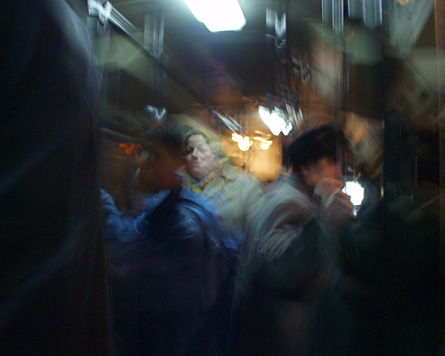 |
 |
 |
Jerusalem, Egged bus line 4
21st January, 2001 |
 |
|
 |
 |
Leitmotifs |
 |
"Genus Loci"
Place is a primordial and permanent preoccupation of this work, it constitutes the theatre which conditions the essence and the progression of the events taking place there. Thus, the point of departure of the photographic act is to probe its genus loci - "sense of place" - so as to situate within it the meaning carried by the subject. This mystery which is place, a thing external to ourselves yet so deeply lodged within our interior domain, where it intertwines with our well-being or our ill-being, is central in piercing the instinctive understanding of ourselves researched through artistic investigation.
"States of Emergencies"
This consists of photographs taken during different political demonstrations, when public space, normally stratified within its use and organisation, is abandoned to human outpouring, seized by the expression of communal demands. In this way, pavements overflow into roadways. Such demonstrations may form spontaneously, following a particular event, a collective trauma of sorts, an example being the demonstrations against Le Pen in France, on the 21st April 2002, the night of the presidential elections. Elsewhere, it may consist of planned and prepared demonstrations, the example being those which go around the world following the annual meetings of the G8.
"Melancholics Anonymous"
Tourism, an economic activity characteristic of modern times, has brought about an extreme commercialisation of place, as source of value indexed upon its capacity of attraction. One comes running, because "it's worth the detour", "worth the visit". In this way, leisure, holidays, won in hard struggle in previous times by the working class, has become a well exploited industrial sector, representing a significant part of the GNP of a large number of countries. There is an innate melancholy in the appropriation of place by holiday makers, hurrying to get as much profit as possible out of the good times before vacation time runs out. This same melancholy accompanies the formatting of tourist sites by their developers, with its reception infrastructure and its profit centres.
"Gutworks"
This is a photographic technique, where the camera, equipped with a wide-angle lens, is placed at the midriff, giving rise to a dialogue with others at stomach level. Our stomachs constitute the breach in our shells, the epicentre of our personal incertitudes, the place where dignity and ridicule cohabit. This genre of photography jostles its subject, it is a point of view from which one's anatomy is laid bare. But it enables to better reveal how one occupies public space, how one lives in it, how one goes about business. It allows one, finally, to expose in a conscious manner the gesture of aggression which underlies the photographic act itself, more so within a society where property law privileges the financial value attached to one's image.
"Ephemerality"
Here one interrogates the role played by composition within the "gutworks" technique, where one is unable to frame the image through the viewfinder: instead one looks at the subject directly, and tries to englobe the ephemeral instant by pointing the camera, placed at stomach level, in the general direction. The resulting composition is imperfect, the aesthetic equilibrium is approximate. By contradicting the desire for control, which expresses itself through a painstaking work of composition, one diverts the static and sometimes sterile nature of an over perfect geometrical construction. Photographing in this way takes account of the natural harmony which infuses the disarray of the real... After all, composition is a mental construction based upon the mind's perceptual templates, that does not exist outside the mind's eye.
|
 |






